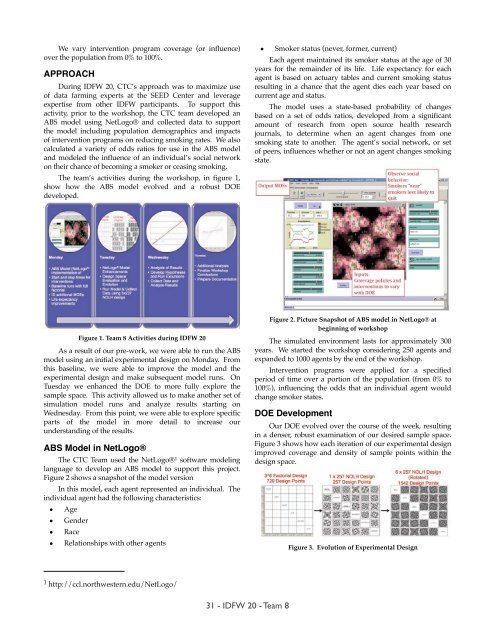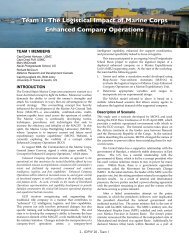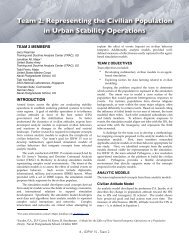pdf file - SEED Center for Data Farming - Naval Postgraduate School
pdf file - SEED Center for Data Farming - Naval Postgraduate School
pdf file - SEED Center for Data Farming - Naval Postgraduate School
You also want an ePaper? Increase the reach of your titles
YUMPU automatically turns print PDFs into web optimized ePapers that Google loves.
We vary intervention program coverage (or influence)<br />
over the population from 0% to 100%.<br />
APPROACH<br />
During IDFW 20, CTC’s approach was to maximize use<br />
of data farming experts at the <strong>SEED</strong> <strong>Center</strong> and leverage<br />
expertise from other IDFW participants. To support this<br />
activity, prior to the workshop, the CTC team developed an<br />
ABS model using NetLogo® and collected data to support<br />
the model including population demographics and impacts<br />
of intervention programs on reducing smoking rates. We also<br />
calculated a variety of odds ratios <strong>for</strong> use in the ABS model<br />
and modeled the influence of an individual’s social network<br />
on their chance of becoming a smoker or ceasing smoking.<br />
The team’s activities during the workshop, in figure 1,<br />
show how the ABS model evolved and a robust DOE<br />
developed.<br />
• Smoker status (never, <strong>for</strong>mer, current)<br />
Each agent maintained its smoker status at the age of 30<br />
years <strong>for</strong> the remainder of its life. Life expectancy <strong>for</strong> each<br />
agent is based on actuary tables and current smoking status<br />
resulting in a chance that the agent dies each year based on<br />
current age and status.<br />
The model uses a state-based probability of changes<br />
based on a set of odds ratios, developed from a significant<br />
amount of research from open source health research<br />
journals, to determine when an agent changes from one<br />
smoking state to another. The agent’s social network, or set<br />
of peers, influences whether or not an agent changes smoking<br />
state.<br />
Figure 1. Team 8 Activities during IDFW 20<br />
As a result of our pre-work, we were able to run the ABS<br />
model using an initial experimental design on Monday. From<br />
this baseline, we were able to improve the model and the<br />
experimental design and make subsequent model runs. On<br />
Tuesday we enhanced the DOE to more fully explore the<br />
sample space. This activity allowed us to make another set of<br />
simulation model runs and analyze results starting on<br />
Wednesday. From this point, we were able to explore specific<br />
parts of the model in more detail to increase our<br />
understanding of the results.<br />
ABS Model in NetLogo®<br />
The CTC Team used the NetLogo® 1 software modeling<br />
language to develop an ABS model to support this project.<br />
Figure 2 shows a snapshot of the model version<br />
In this model, each agent represented an individual. The<br />
individual agent had the following characteristics:<br />
• Age<br />
• Gender<br />
• Race<br />
• Relationships with other agents<br />
Figure 2. Picture Snapshot of ABS model in NetLogo® at<br />
beginning of workshop<br />
The simulated environment lasts <strong>for</strong> approximately 300<br />
years. We started the workshop considering 250 agents and<br />
expanded to 1000 agents by the end of the workshop.<br />
Intervention programs were applied <strong>for</strong> a specified<br />
period of time over a portion of the population (from 0% to<br />
100%), influencing the odds that an individual agent would<br />
change smoker states.<br />
DOE Development<br />
Our DOE evolved over the course of the week, resulting<br />
in a denser, robust examination of our desired sample space.<br />
Figure 3 shows how each iteration of our experimental design<br />
improved coverage and density of sample points within the<br />
design space.<br />
Figure 3. Evolution of Experimental Design<br />
1 http://ccl.northwestern.edu/NetLogo/<br />
31 - IDFW 20 - Team 8




